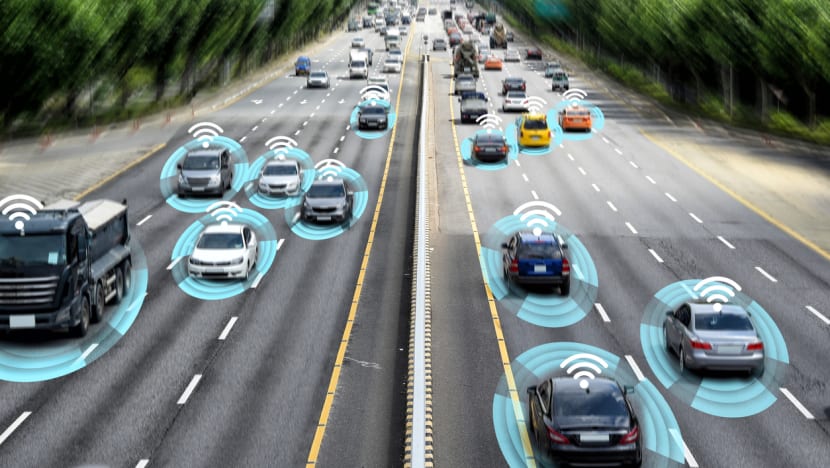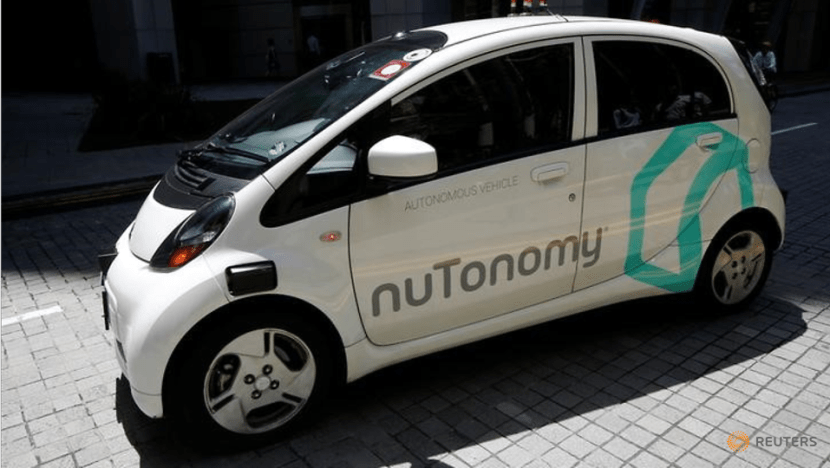Commentary: Is Singapore ready to have driverless cars on its roads?
Several cities in the US and China have already put driverless cars into commercial service. SUSS’ Ku Swee Yong and Dr Sheila Conejos look at how close Singapore is to weaving this technology into its transportation mix

Illustration of self-driving cars on roads. (Image: iStock/Jae Young Ju)
SINGAPORE: Autonomous vehicles - are we there yet? The short answer is yes. If “arrival” is defined as the paid and commercial use of autonomous vehicles (AVs) to transport commuters safely and efficiently, we can say that the technology for driverless cars has arrived.
In the United States, commuters can hail AV rides using their mobile devices in Phoenix, Arizona and in San Francisco, California. In China, AVs have been licensed to ferry commercial passengers in Chongqing and Wuhan since August 2022.
Variously referred to as driverless cars, self-driving cars and robotaxis, these commercial taxi rides operate without safety engineers and human operators on board the AVs.
FROM SCIENCE FICTION TO REALITY
The idea of AVs was imagined more than 100 years ago. Writing for Scientific American magazine in January 1918, journalist Carl H Claudy envisaged “a motorist’s dream: a car that is controlled by a set of push buttons” and “In the future the car with the steering wheel will be as obsolete as the car with the hand pump for gas or oil is today!”.
Subsequently, science fiction novels by David H Keller, Isaac Asimov and Arthur C Clarke, as well as superhero comics, featured AVs with a wide range of capabilities, including many that could fly or traverse the oceans.
General Motors presented their early vision of AVs at the Futurama exhibit in the 1939 World Fair in New York. Their display portrayed radio controlled electric automobiles powered by circuits embedded in the road surface. In General Motors’ “wonderworld of 1960” vision, there were no traffic jams and no road accidents.
The journey towards full autonomous driving has taken us many decades. The technology is a bit more familiar to many of us now as we see robot vacuum cleaners navigate around pieces of furniture in our homes, robot trolleys serving dishes from restaurant kitchens and autonomous delivery vehicles bringing parcels and food in some of our neighbourhoods.

PROGRESS MADE AROUND THE WORLD
Technologies supporting fully autonomous vehicles have improved enormously in the last decade. A surge in technology financing in 2020 and 2021, coupled with lockdowns and restricted travel movements due to the COVID-19 pandemic, helped accelerate investments and increased testing of AVs.
Waymo, a subsidiary of tech giant Google, is probably the most advanced developer of AVs.
As of 2021, the Waymo’s AVs have driven more than 20 million miles (32 million km) on roads across more than 25 cities in the US, and completed more than 20 billion miles in simulated trials.
Compared with an average human driver who may clock about 30,000km a year, the Waymo Driver has accumulated several thousand lifetimes of driving, and across a significantly wider range of traffic scenarios and environmental conditions.
To top these impressive achievements, Waymo has consistently been transparent about their safety performance data. A report released in October 2020 revealed that there were no “at-fault” incidents by the Waymo vehicle over 6 million miles, or about 8 lifetimes of human driving, on actual streets. This compares exceptionally well with human drivers who, driving the same distance, would have recorded six injury-crashes.
Presently, hundreds of AV companies and academic institutions around the world are racing to research and run trials, including in North America, Europe, China, Australia, Japan, and South Korea.
Several cities in the US and China have already put AVs into commercial service and more cities are expected to follow. During the July 2021 Tokyo Olympics, Toyota showcased their leadership in AV technology to the world by deploying a fleet of driverless electric cars to ferry athletes between venues in the Olympic Village.

SINGAPORE’S AV JOURNEY
Singapore is also on board the AV bandwagon. Since 2014, AVs have been undergoing trials in low traffic environments.
For example, a driverless taxi from nuTonomy, a spinoff from the prestigious Massachusetts Institute of Technology, was trialled in the one-north district. A driverless Volvo bus was on trial in Nanyang Technological University (NTU) and the MooBus, deployed by homegrown company MooVita, began driverless bus services in Ngee Ann Polytechnic recently.
The Land Transport Authority (LTA) has articulated a wide range of benefits that AVs will bring, such as improving traffic safety, increasing productivity by reducing congestion and optimising road usage.
To support AV research, the LTA, NTU and JTC set up the Centre of Excellence for Testing & Research of Autonomous Vehicles (CETRAN) in 2017 and a test circuit of 1.8 hectares was built for AV trials at CleanTech Park.
In January 2022, the Urban Redevelopment Authority (URA) created a public exhibition titled Reimagining Urban Mobility with Autonomous Vehicles as part of a public engagement under its long-term planning review. Such efforts reach out to a wider range of stakeholders, particularly road users and commuters. Property developers and building owners are also reminded that AVs will be woven into the transportation mix in Singapore’s future urban landscape.
With so much going on around the world, it seems that many of the top cities around the world are on the cusp of putting AVs on the roads. Already the early adopters and enthusiastic fans of AVs have begun posting videos of their AV rides on social media platforms such as TikTok, YouTube, DouYin and YouKu.
SHOULD WE GO THERE?
As commercial taxi operations in US and China have evidenced, AV technology is “already there”. The question is, should Singapore introduce AVs into our transportation mix? What are the benefits and what are the risks of adoption?
And if the answer is positive, we should consider whether Singapore is ready to include AVs into our transportation mix. Furthermore, with one of the highest population densities in the world, we need to consider the potential impact AVs will make on our urban landscape and the existing built environment. Compromises and investments will have to be made before we can take advantage of the benefits that AVs can bring.
Ku Swee Yong is a post-graduate researcher from the Singapore University of Social Sciences and Dr Sheila Conejos is the Head of Master of Built Environment Programme at the same institute.
This commentary is the first of a three-part series on autonomous vehicles and how Singapore might benefit from the advantages that this new technology could bring.

No comments
Share your thoughts! Tell us your name and class for a gift (: